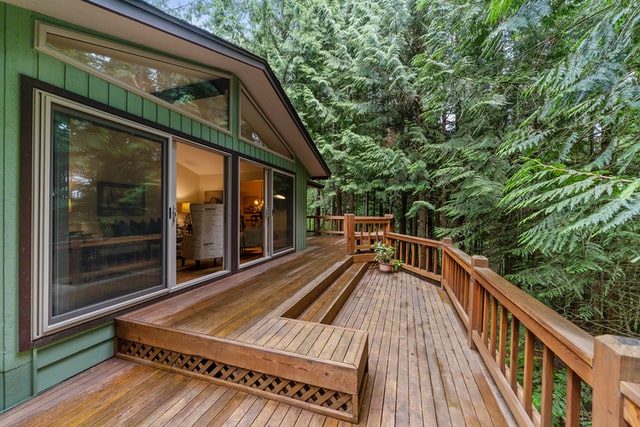There are several different types of support for a deck. You can use rim joists, which are the beams under the deck. These are typically placed on the perimeter of the deck. They are often attached to posts by beam brackets or cleats, which can be space and cost-saving. Some support systems include railings, which add a finishing touch to the deck.
Posts
A sturdy structure should support the substructure components to construct a high-quality deck. Wooden decks often feature traditional rim joists and a frame made of support posts. However, traditional wood is susceptible to damage and decay from moisture and weather. Concrete pillars, which support the deck frame, are an excellent choice. They’re poured into holes dug in the ground and extend below the frost line to prevent shifting. In addition to supporting the deck frame, these pillars also support the beams and floor joists.
Adding a deck to your home adds significant curb appeal, which boosts the value of your property. It also makes your home stand out from the competition. In addition to enhancing the look of your home, choosing the right type of material will add to its curb appeal. For instance, composite materials can make a deck look incredible and add value to your home. If you want your deck to be structurally sound, you’ll need to install a solid frame, and it’s worth the extra money.
Railings
Deck railings are a great way to add style to a home and provide structural support for the entire structure. Unlike other deck railings, glass and metal railings are safe and sturdy. Manufacturers of steel railings can design the pieces to match the design of your home. In addition to their durability and aesthetics, metal railings are also relatively low-maintenance. All they require is a wipe-down once in a while.
When choosing a railing system, make sure the measurements are correct. Sketch out your deck to see precisely how much material you will need. Remember to match newel post layouts with rail lengths in the rail system when installing railings. Choose the appropriate rail sections because sometimes the nominal sizes do not check the actual measurements. To avoid a mismatch, consider using a railing system rated for up to 200 pounds of force.
Blocking
Adding blocks to your deck frame is a good idea for many reasons. First, blocking can prevent bounce or sway and strengthen your deck. Blocking is more cost-effective to install during construction than retrofit after the fact. Blocking is often fastened with 10d nails or screws for increased shear strength and pull-and-hold abilities. However, some builders use specially designed structural screws to reinforce the deck frame.
Mid-span joist blocking is an excellent way to improve the structural stability of your deck. It adds rigidity to long joist spans, preventing joists from twisting or bouncing. Suppose you decide to use blocking, select material that matches the joists’ finish. For example, blocking made from framing cut-offs is a good choice.
Pergola
There are many advantages of using deck support for your pergola. It can help it remain stable and free of sagging when placed on a deck. However, since it is higher than a pergola located in the yard, it is also more susceptible to wind movement. Thick galvanized steel fasteners are the most important consideration when mounting a pergola on your deck. Moreover, you should choose ones with an extra coating for additional protection. Moreover, railings are an excellent choice for sturdiness.
Once you have installed the pergola, you should consider the types of plants that will grow there. Some of these plants require more assistance, such as climbing roses. However, if you decide to use climbing plants on your pergola, make sure you find out the exact support requirements of each type of plant. Wisteria and roses, for example, need more help to climb the pergola posts. In these cases, you can purchase pergola support kits to take care of the issue.
Bench
When you install a new deck on your property, you may want to consider installing deck support to ensure that your bench stays level. Unlike a freestanding deck supported by the entire structure, deck support requires a concrete pier or concrete wall. While this type of support is necessary, it will also ensure that the bench will stand firm and sturdy in the long run. The benefits of deck support will also allow you to install a pergola or benches on your deck.
For starters, deck posts are attached to the top of the footings by metal brackets. A more complex design may require bracing to support an enormous deck over a slope. Be sure to check building codes before installing deck support. Also, be sure to check local building codes. Once you have installed the posts, you should install beams that support the deck frame. Beams can be installed along the rim joists or intermittently between them. That is why versadjust adjustable deck supports are important.
Wire mesh
When choosing wire decking, it is essential to consider the load’s weight capacity, shape, and size/density. Stock wire decks are designed for a uniformly distributed load (UDL). It would be best to use a custom deck for loads that fall outside this range. In general, the UDL is defined as the weight distribution of a load over the entire deck surface, the entire length of the support channels, and the area between the front and rear load beams.
There are different types of wire decking available, and each style has its advantages and disadvantages. Standard wire decking drops over the sides of the beam while u-channels rest on the shaft. Traditional wire decking offers the highest strength and durability and allows for the storage of various products. Wire mesh decking has a low cost and is an excellent option for warehouses that store multiple products.

